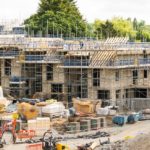Features - Development
Creating Industry Wide Benefits By Making Approved Inspection Integral

Richard Cymler is Regional Director at Ball & Berry, in this latest feature, he looks at the changes to building regulations and how they often occur much more frequently than many may be aware.
Labelled A through to R, each approved document focuses on a specific part of building regulations. In the last 12 months alone, parts B – fire safety – and M – accessibility – have been amended and have come into effect. On the horizon, parts L – energy conservation – and F – ventilation – will have updates published that will not only become legal requirements, but which look set to drive the future of many design trends.
The responsibility is not on designers, architects or contractors to know the ins and outs of these parts of building control; it is on us, as approved inspectors and experts in this area of construction to work alongside the supply chain to ensure all legal requirements are met in their specification and on site delivery. That goes without saying.
However, to this day, it’s uncommon that approved inspectors are part of a build project any earlier than Stage 3 or even Stage 4 in the RIBA design process. Despite our ability to share vast amounts of knowledge and offer greater design certainty at the earliest stages of a concept, approved inspectors are often appointed so far down the line that the developer and development in question face may disruption and delays, must make changes to their established layouts, have to waste ordered materials and, in extreme cases, are unable to secure final certificates.
There’s an element of complacency in the industry which is allowing this decision to be made repeatedly, and it’s creating a ripple effect that needn’t be there. Approved Inspectors are not the same as a clerk of works; from scrutinising paper designs and carrying out periodic site checks to ensure work adheres to regulations, to identifying if stair cases are wide enough to meet fire safety regulations and advising on the most suitable materials to be placed on the outside of buildings for safe use, we see each and every development as an individual, bespoke design requiring a tailored approach. Those who don’t feel the need to involve approved inspectors at the earliest stages of their project are relying on their knowledge of previous developments to make judgements on a current one – but unless the two are identical in every way, our recommendations would differ significantly.
This pattern needs to be flipped on its head, for several reasons, because involving approved inspectors at the pre-planning stages of a project can deliver huge benefits for individual projects and the industry as a whole. If appointed at Stage 2 in the RIBA design process, developers will be armed with building control experts who can highlight aspects of a design that won’t meet requirements and address potential errors before a design even goes to planning, let alone before the project gets to site. It’s the same job we’d be doing six months later, except that highlighting areas of non-compliance at this later stage often involves rework.
There’s a widespread belief that involving approved inspectors earlier in the design process might cost more but this simply isn’t the case; fees tend to be staggered throughout the project timeline so while there might be an upfront fee for our initial design reviews and advisory recommendations, it works out as no more across the whole project scope. And more importantly, we’ll be able to spot the things that might not be designed to regulatory standards and which, if amended later down the line, will cost more – so, in fact, utilising the expertise of building control at the start of a project can save money.
The most important element – which results in preventing time delays, saving money and avoiding wasted materials – is, of course, to get your design right, first time. Design and building control accuracy is something we feel so passionately about, that we recently teamed with the Get It Right Initiative (GIRI) to push for better and earlier collaboration between all project stakeholders, and at all levels of the supply chain, to help eliminate avoidable errors – one of GIRI’s core principles. By sharing our message with its broad membership spanning various sectors of the industry, we hope to create a change in practice – or habit – which encourages specifiers to place building control at the centre of their designs, to create futureproofed, safer buildings that are fit for purpose and delivered to their best possible standards first time round.
We’re taking this further by offering clients bespoke CPD sessions on any regulations changes that come into play so that they can learn alongside us about what the updates mean for their upcoming developments. Doing so allows us to educate designers and architects on the questions they need to be asking about building control at the offset of their projects, so they’re provided the certainty that their vision is buildable, compliant and safe.
This isn’t simply a willingness from the approved inspector market to be involved at Stage 2; it’s now a necessity if developers want to maximise on the time, cost and sustainability benefits available to them throughout a build cycle. Approved inspectors are a solution to many different challenges; we want people to engage us, utilise us and learn from us for their own advantage. Doing so will help improve the reputation of the entire industry – which is a passion I’m sure we all share.
If you would like to read more stories like this, then please click here
Related Articles
More Features
- Why early MEP design collaboration holds the key to smarter buildings
24 Jun 25
Working closely is essential to ensure that all aspects of a building’s design contribute to
- Risk Vs Reward: Labour’s ambitious plans for stalled housing developments
10 Jun 25
Labour’s plans to allow local authorities to take control of stalled housing sites signals bold
- Insight: Digitalisation and the future of low-carbon housing
23 May 25
Digitalisation is reshaping homes, playing a pivotal role in reducing carbon emissions and enhancing energy






